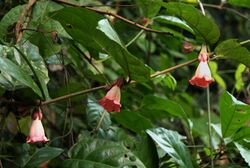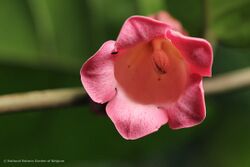Biology:Sherbournia bignoniiflora
| Sherbournia bignoniiflora | |
|---|---|

| |

| |
| Scientific classification Error creating thumbnail: Unable to save thumbnail to destination
| |
| Kingdom: | Plantae |
| Clade: | Tracheophytes |
| Clade: | Angiosperms |
| Clade: | Eudicots |
| Clade: | Asterids |
| Order: | Gentianales |
| Family: | Rubiaceae |
| Genus: | Sherbournia |
| Species: | S. bignoniiflora
|
| Binomial name | |
| Sherbournia bignoniiflora (Welw.) Hua
| |
| Synonyms | |
| |
Sherbournia bignoniiflora is an African scandent shrub or liane with large, showy, bell-shaped flowers belonging to the family Rubiaceae and found in equatorial West African evergreen forests in Cameroun, Benin, Gabon, Sudan, Uganda, Democratic Republic of the Congo, Nigeria, Sierra Leone, Ivory Coast, Zambia and Angola. It is one of some 14 species in the genus Sherbournia.[1][2]
Uses
Besides its ornamental value the species' leaves and bark are used in decoctions and infusions for a variety of ailments and conditions - the seed-coat mucilage as a pain-killer, the bark and leaves against pulmonary problems, stomach ailments, roots to combat cutaneous and subcutaneous parasitic infections, and the bark for aphrodisiacs and febrifuges. The stems produce tough fibres used as general purpose binding material.[citation needed]
References
External links
Wikidata ☰ Q15447836 entry
 |

